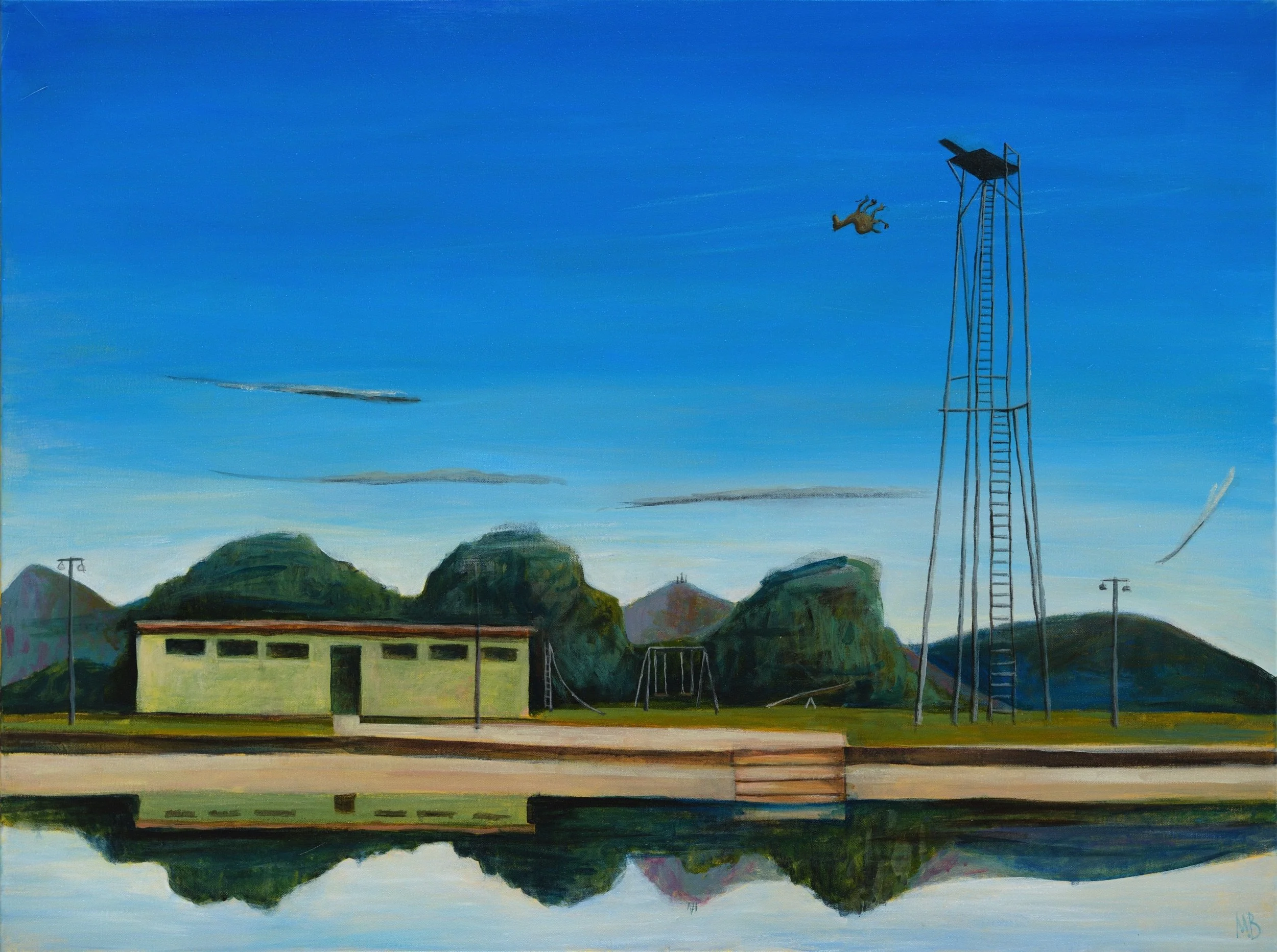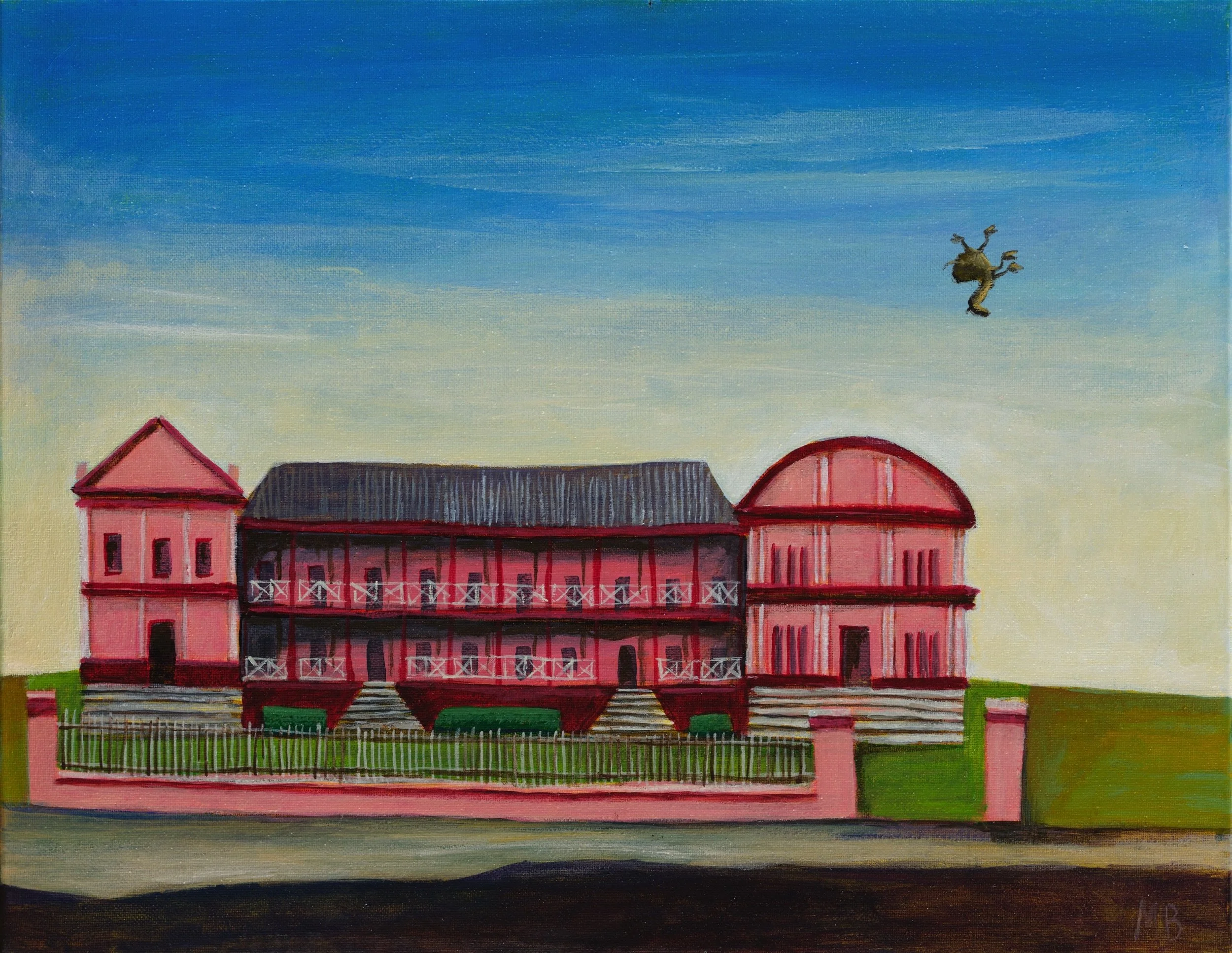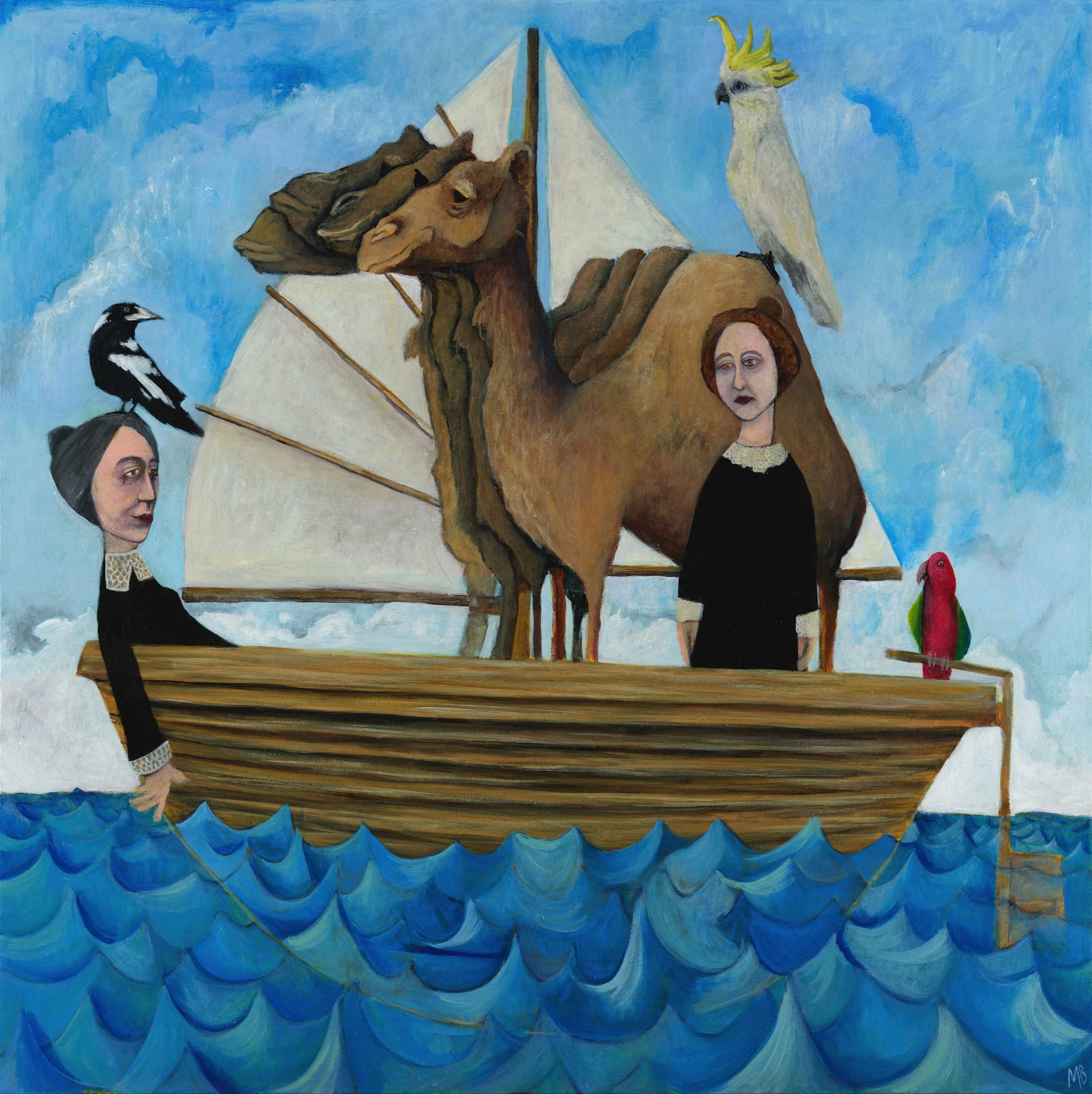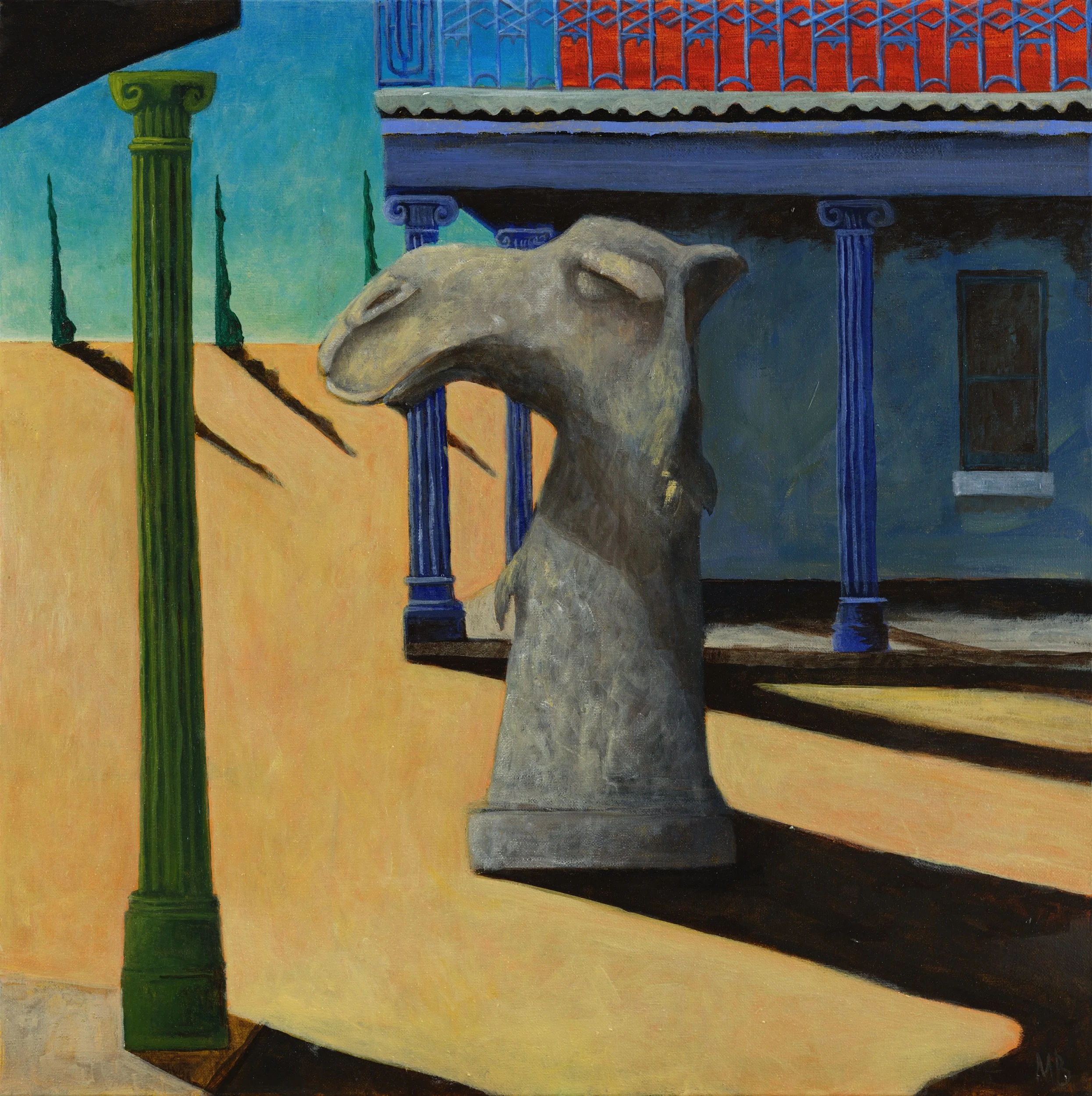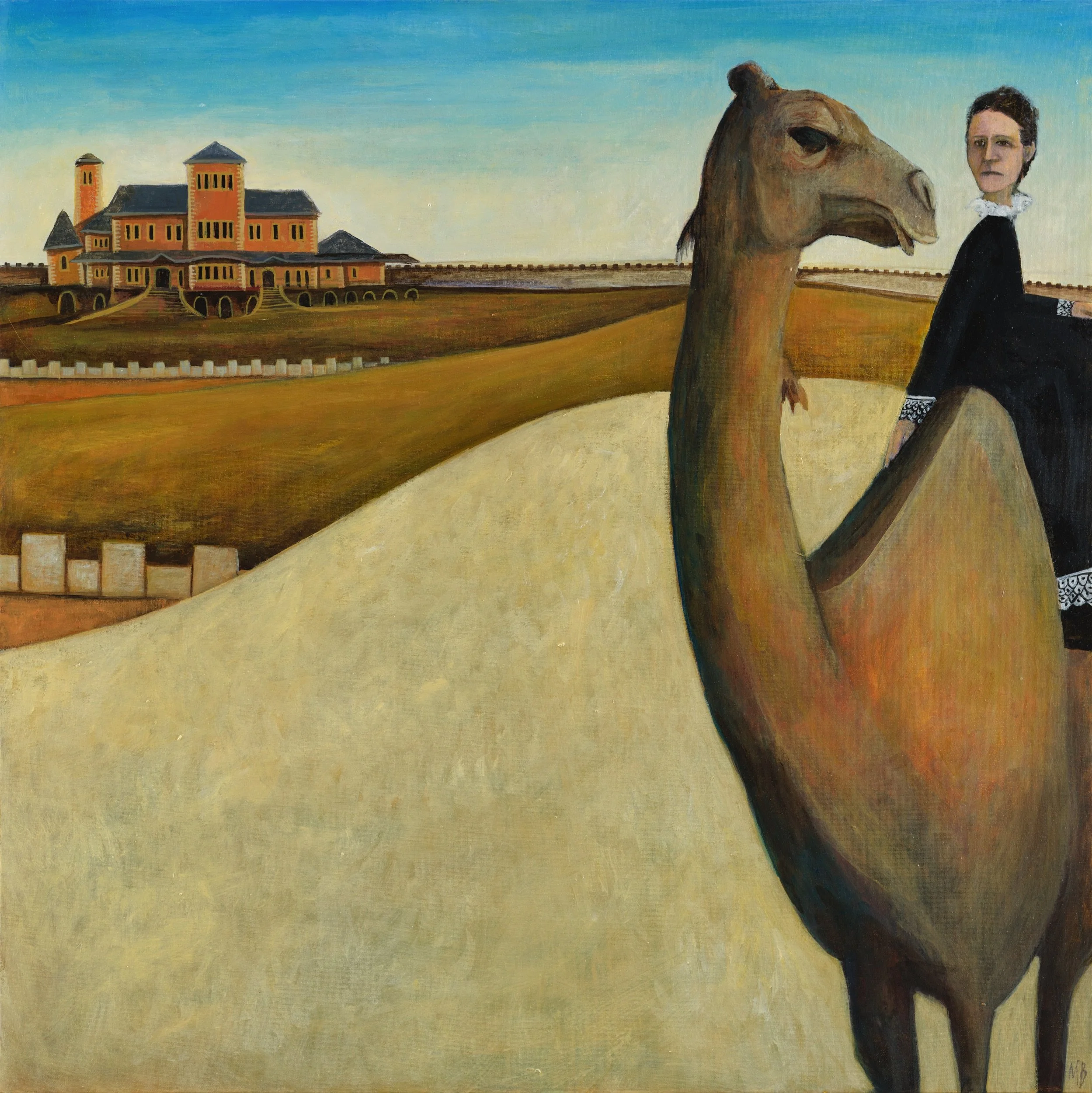Fables of the Mudgee Camel
The amazing and mostly true story of Adolphus George Taylor
Rosby Gallery 2023
A miracle of sorts - A camel is born, 2023
Acrylic on canvas, 75 x 100cm
Although childbirth is completely pain free nowadays, in olden times it used to hurt quite a bit. For Sarah Burton, nee Shellum, things were even more tricky.
It is hard to know just who Mr Burton was and whether he was still alive when Sarah fell pregnant; it certainly seems unlikely that he was in the room at the time. If he was alive, this Mr Burton must have been a very easy-going sort of fellow, for on the birth certificate of his wife’s child, in the space reserved for “Father” rests the name “George Taylor.”
George Taylor’s profession is noted as “Gentleman”, suggesting that he undertook philandering on a purely volunteer basis. It is hard to know how long George Taylor hung around after the birth of Adolphus and it is equally hard to imagine he and Mr Burton enjoying a night around the pianola.
Considerable controversy surrounds the identity of the man in this studio portrait taken at Charles Worthington’s photographic rooms in Mudgee. For many years it was assumed to be the elusive Mr Burton, others claim the gentlemanly posture suggest that it may in fact be George Taylor. Relatives of Charles Worthington have commented that the face has a striking resemblance to the proprietors photographic assistant, Alexander Pittson.
Beyond dispute however is the observation, that even from this earliest of records, Adolphus was somehow different from other children.
First you must obey - A camel in line, 2023
Acrylic on canvas, 30 x 30 cm
To feed a man for a day, give him a fish. To feed a man for life, teach him to fish. If he doesn’t fancy fish for every single meal, teach him to line up at the shops.
Adolphus Taylor started school at St John’s Anglican School in Mudgee some time in 1861. Almost immediately, he showed a precocious ability and enthusiasm for lining up. It was as if it was somewhere deep inside his D.N.A, although strictly speaking, it would be another ninety years before D.N.A was discovered.
A glimpse of freedom – A camel in space
Acrylic on canvas, 100 x 75 cm
A somewhat awkward and chubby youngster, in his early teens, Adolphus became increasingly self-conscious about his body. At school he became the subject of taunts and of cruel nicknames including “a somewhat awkward and chubby youngster”.
It was whilst enjoying a solitary afternoon at the Mudgee Baths in Lawson Park that Adolphus first became aware of the fact that his body would become a vehicle that would take him to places that others would never know.
A challenge to authority – A camel interrupts
Acrylic on canvas, 60 x 60 cm
Adolphus’ unusual intelligence soon became evident to all, even his teachers. The young scholar excelled at navigation, alchemy and abacus but soon became frustrated by the quality of tuition. Having read and memorised all seven of the books at St John’s Anglican School, Adolphus was well placed to point out the inconsistencies and inaccuracies of his teachers, which he did regularly.
Before too long, it was decided that it would be in everybody’s best interests if Adolphus were allowed to teach.
Authority challenges itself – A camel storms off to the Lawson Park Hotel
Acrylic on canvas, 60 x 90 cm
“Whilst teaching one afternoon a small bird flew into the classroom” recalls Adolphus. “It was a regent honey eater, the place was always lousy with them back then and they were always flying into the class room. Ofcourse, the moment there was a bird in the class, all the pupils were distracted beyond any hope of learning. So I just stopped teaching mid-sentence and watched this bird as it flew about the class room. At first the bird just seemed surprised to be indoors, and then, with the noise of the students, all laughing and screaming, you could see a sense of anxiety rising in its little frame as it lapped the room switching directions every few circuits.
And then I saw the bird switch in to full panic mode, its tiny little heart must have been beating so hard as its head tried to make sense of the situation, to work out how on earth it had come to be in this utterly strange space full of people with no way out.
It spotted a window and flew straight for it, smashing it’s little head against the glass. It made quite a noise, it must have hurt but the bird was too worked up to worry about the pain that it was inflicting on itself, it circled the room again an flew back into the glass. I moved over to the window and slid open the pane, only to watch the bird fly into the one closed section, again and again. The children of course all thought that it was hilarious.
I then moved over to the doorway, and pushed the door wide open. A lovely breeze blew into the room but that bird just kept banging itself against the same rigid piece of glass, its surface now greasy with bird sweat and feathers.
The laughing, the screaming, the banging of heads, the sheer stupidity of it all - I walked straight across the road to the Lawson Park Hotel and never set foot inside that classroom again.
The journey begins – A camel leaves home
Acrylic on canvas, 75 x100 cm
Newly unemployed and still hung over, Adolphus left Mudgee that next morning.
“It occurred to me that there was a whole world out there. I’d been stuck, not only in this little classroom, but in this little town for far too long. I thought about those summer afternoons in my early teens down by the Cudgegong, tumbling through space, I remembered the freedom that I had felt and straight away I knew what I was going to do. I was going to join the army.”
Kicking against the pricks – A camel and the NSW Permanent Artillery
Acrylic on canvas, 90 x 60 cm
Australia didn’t have an army back then. In fact, Australia didn’t even have an Australia back then, so Adolphus joined the New South Wales Permanent Artillery.
Given his love of order and accuracy, Adolphus had assumed that the army would be a perfect fit.
“Stationed in Darlinghurst, there was a fair bit of dressing up and parading around. For a while it was fun, but we never seemed to go anywhere.
And of course, you were constantly taking directions from idiots.”
The punishment - A camel in jail
Acylic on canvas, 40 x 60 cm
“Apparently refusing to do follow the foolish dictates of a moron is a big deal in the army. They have a word for it - Insubordination.”
Adolphus was charged with Insubordination in July 1857 and spent several months in Darlinghurst Jail or Darlinghurst Gaol as it was known back then. Sharing a rat -infested cell with hardened criminals, Adolphus had an opportunity to reflect, not only on his own life, but on the society that he had been born into. Always something of an odd bod and an outsider, Adolphus was struck by the injustices and brutality that seemed to be sewn into the very fabric of life. He decide that he would change the world, that he would rip that fabric apart.
But to change the world, one must first understand it. Upon release, Adolphus decided, he would go in search of truth.
And there was no better place to look for truth, than back in Mudgee.
In search of truth – A camel returns home
Acrylic on canvas, 100 x 75 cm
Already struggling with alcohol, it made sense that Adolphus should go into journalism.
At the time, Mudgee was home to a remarkable 73 Newspapers. With so much happening, and so many people needed to write down what was happening, Adolphus had no trouble getting a job at the Mudgee Independent.
In search of beer – A camel is shut out of the Federal Hotel
Acrylic on canvas, 90 x 90 cm
At the time, Mudgee was home to a remarkable 73 Hotels.
When not banging away on the type writer or going undercover to chase down a story, Adolphus would spend his time propped up on a bar stool listening to the stories of workers, loafers, criminals and the common man. The common woman wasn’t allowed into pubs at the time, so he never really got to listen to their stories.
In. his columns, Adolphus was able to capture the fears and frustrations of the common man and give them a voice. The fears and frustrations of the common woman didn’t matter so much, women couldn’t vote in New South Wales.
The Premier humbled – A camel rises to power
Acrylic on canvas, 100 x 75 cm
Adolphus’ writing on politics must have struck a chord with the public because when he ran for election to state parliament he was able to take down local hero John Robertson to win the seat of Mudgee. Robertson was hugely popular as a result of reforms that he had introduced to break up the monopoly of the “squattocracy”.
The squattocracy were a small group of white people who had wandered all over Australia grabbing land for themselves and turning it into farms without negotiating with or compensating the traditional owners. By the mid 1800’s they had taken most of the country. John Robertson was one of the first to see the great injustice that this land grab had led to and introduced new laws to ensure that land should be distributed in a more fair and ordered way, with white people selling smaller bits of it to other white people whilst still ensuring that aboriginal people receive no compensation.
By the time that Adolphus Taylor won the seat of Mudgee, John Robertson had been premier of the state for four terms. He wasn’t expecting to lose his seat to a 25-year-old camel. Taylor once referred to Roberston as “another great drinking man.” He is shown here escorting the former premier to the Woolpack Hotel for a commiserate schooner.
A nimble mind and an acid tongue: a camel is ejected
Acrylic on canvas, 50 x 40 cm
Within weeks of taking his seat in Parliament, Adolphus introduced new legislation to ban flogging. In a further move that would have upset many of his former teaching colleagues, he also introduced legislation to ban the teaching of history in schools until someone could write a decent history book.
In next to no time, Adolphus also managed to memorise the entire New South Wales constitution. He took great pleasure in drawing attention to procedural inconsistencies and regularly heckled his opponents for their ineptitude and stupidity. When this got boring, which was usually by about 2.30pm, Adolphus would get drunk.
Australia’s future first Prime Minister, Edmund Barton was another man who liked a drink. As Parliamentary Speaker, Barton made a point of having a rum and milk smoothie for breakfast; it somehow seemed to help him cope with all the frustrations and challenges of such an important job.
When Barton ran out of rum one day, he had no choice but to have Adolphus thrown out.
A mind too nimble, a tongue too acid: a camel is ejected again
Acrylic on canvas, 50 x 40 cm
Adolphus was banned from the Parliament for a week for being drunk and abusive, which he most likely was. Upon his return Barton had him ejected and banned for another week for being drunk and abusive. Taylor claimed that he was not drunk on this occasion, merely abusive. Whilst sailing through the air above Macquarie Street, he swore he would have his revenge on Edmund Barton.
The triumphant return: a camel falls apart
Acrylic on canvas, 90 x 90 cm
Taylor successfully sued Edmund Barton for £1000 but Barton refused to ‘take his outs’ and appealed to the Privy Council in England.
In order to get his £1000, Taylor decided to sail to England to win the case. As a child he had wanted to be a barrister so he thought it might be fun.
In order to fund the trip, Taylor sold his stamp collection and gave public talks on ‘The iron hand of politics’ and ‘Why Edmund Barton is a complete tosspot’. He took his wife, his mother, a cockatoo, a magpie and a parrot with him.
With absolutely no training or assistance, Adolphus won the case and in record time the judge ruled that Edmund Barton, certainty did sound like ‘a complete tosspot’.
It was on the way back from England that Taylor started to fall apart.
He realised the £1000 would be paid for by the NSW Parliament and not Edmund Barton. Full of both spite and integrity, Adolphus refused to accept the money.
Notes from the underground: a camel’s gospel (with thanks to Giorgio de Chirico)
Acrylic on canvas, 60 x 60 cm
Upon his return to Australia, Taylor headed off in multiple directions all at once. He resigned from Parliament, became the state examiner of patents, opened Echo Park a ‘hospital for male inebriates’, got drunk, became the editor of the ironically named ‘Truth Newspaper’, got mixed up as a witness in a rape trial involving a man masquerading as a priest and then sat down to write a novel.
The Marble Man, published in 1889, is the memoir of a statue. A rare but brilliant book, it makes almost no sense whatsoever.
In madness and chains: a camel’s disintegration
Acrylic on canvas, 60 x 60 cm
Adolphus Taylor entered Callan Park Hospital for the Insane in 1898. He faced brutal and ineffective therapeutic interventions but on sunny afternoon walks in the garden, he would sometimes bump into former Mudgee Post Mistress, journalist, and inventor of female suffrage, Louisa Lawson.
The two inmates would talk about stamps and life back in Mudgee. They both remained firmly convinced that Edmund Barton was ‘a complete tosspot’.


